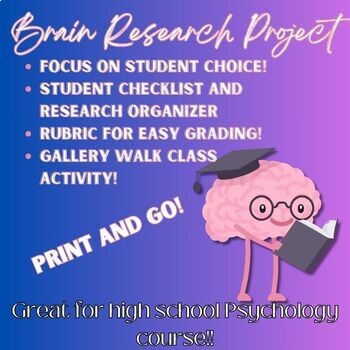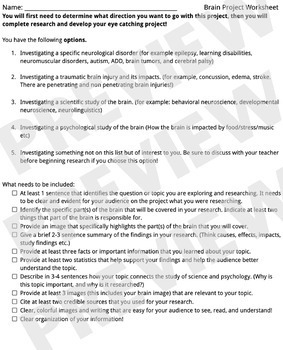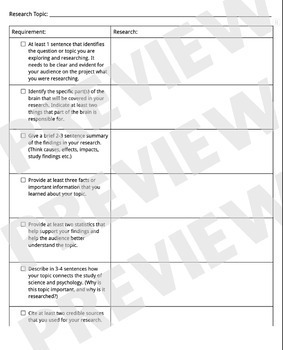Psychology Brain Research Poster Project
- Zip
Description
High School Psychology Brain Research Poster Project
Engage your high school psychology students in an enriching and comprehensive exploration of brain-related topics with the Brain Research Poster Project! This versatile and engaging educational package empowers students to delve into various facets of the brain, fostering their research skills and creativity through the creation of visually stunning and informative posters.
Key Features:
1. Student Choice: Encourage student autonomy and interest by offering a wide array of brain-related topics for research. From neuroplasticity to brain disorders, neurotransmitters, cognitive functions, and more, students have the freedom to select a topic that resonates with their curiosity.
2. Comprehensive Resource Package:
- Project Requirements Checklist: Keep students on track and accountable with a detailed checklist outlining the essential elements necessary for their posters.
- Research Graphic Organizer: Facilitate structured research by providing students with a comprehensive graphic organizer. This tool assists in organizing thoughts, sources, and key findings for a coherent presentation.
- Grading Rubric: Streamline the assessment process with a thorough grading rubric designed to evaluate content accuracy, creativity, visual appeal, and presentation skills.
- Gallery Walk Graphic Organizer: Foster collaborative learning and peer-to-peer engagement through a specially designed graphic organizer for a whole class gallery walk activity. This encourages students to analyze and learn from their peers' projects.
3. Skill Development:
- Research Skills: Empower students to navigate reliable sources, synthesize information, and articulate findings effectively.
- Visual Representation: Encourage creativity and critical thinking through the creation of visually striking and informative posters. This aspect enhances students' abilities to convey complex information in an engaging manner.
Benefits:
- Student-Centered Learning: Promote autonomy and engagement by allowing students to choose topics of personal interest.
- Holistic Assessment: Evaluate multiple skills including research, critical thinking, creativity, and presentation through the project and rubric.
- Collaborative Learning: Encourage peer-to-peer learning and discussion through the gallery walk activity, fostering a deeper understanding of various brain-related topics.
With this resource, you'll facilitate a dynamic learning experience that not only meets curriculum objectives but also nurtures students' curiosity, research capabilities, and visual communication skills. Empower your students to explore the fascinating world of the brain while showcasing their knowledge and creativity through this Brain Research Poster Project!
⭐️⭐️⭐️⭐️⭐️ Don't forget to leave a rating and review to earn TPT Credits! Your feedback helps enhance these resources and supports fellow educators in making informed choices.





